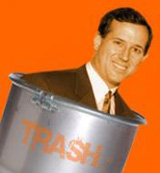Freedom is Ignorance: Freedom of Religion Edition
The Christian Science Monitor, despite the ongoing, terrible drama of kidnapped CSM freelance journalist Jill Carroll in Iraq [ and the negotations surrounding her fate- don't they know that this kind of death threat doesn't help their cause or their case? The AntiC's heart goes out to Ms. Carroll and her family], continues to put out compelling cultural analysis uncovered by other large media outlets. Today's edition: The misunderstanding of the constitutional right to free religious practice on the right, and the left:
It's distressing to see people like Rev. Rob Schenck set up Christmas displays in Washington in aggressive "protest" to the secularization of society. Schenck's method was one of ridiculous entrapment: He set up a manger scene on his own property across the street from a federal courthouse. If the Feds told him to take it down, he'd cry out in freedom-of-religion whining. If they let it stay up; he'd call out that they were therefore unjust, because they did not have a display of the 10 commandments up.
So the perception is this: no matter what, we're right. And you all are wrong. And not only are you wrong, but you're oppressively wrong- you've stomped on my religious freedom and you refuse to acknowledge it.
Without ever considering the fact that his ability to practice his religion is his religious freedom- and that by attempting to inflict his religion on everybody else, he's then becoming the aggressor, the oppressor, and refusing to acknowledge it.
It's interesting that the CSM traces this problem back to what it calls the "secularization" movement [loosely defined as a movement by me, not the CSM]. There is nothing in the piece to tell when this occured, or what prompted it, but I think most would be place this roughly during Vietnam period in America- where the culture became in conflict with itself against the conservative structures of the post-war 50's, Leave it to Beaver world. Everything conservatives talk about seems to point back to this period- it's as though they seek to reclaim their lost childhood innocense; while the rest of us just realize that that is not only impossible, but foolish to attempt.
"While Americans do count freedom of religion as one of our most precious rights," says Audrey Smith, acting director of the Council for America's First Freedom, in Richmond, "many citizens aren't sure how they exercise those rights, or what is not allowed under our Constitution."It's simple, o' hallowed AntiCentoniacs: once the Church and the State no longer are independent bodies, but refer officially and consistently to one another, religious freedom doesn't exist.
A national survey by the council in October, for instance, revealed a deep ambivalence about a fundamental principle of religious freedom: the separation of church and state.
While 47 percent of those polled said it is important to keep the traditional principle, 27 percent said it should be less strictly interpreted, and 23 percent said "there is really no need to separate church and state."
"I think folks don't understand what that means," Ms. Smith says. The separation is what makes religious freedom possible.
Another popular misperception relates to religious freedom in public schools. In the 2005 State of the First Amendment poll, 50 percent of respondents said students have "too little religious freedom." Yet students are free to pray individually or in groups, to form religious clubs and publications, to express religious views in their school assignments, and wear religious messages on their clothing. Unfortunately, many educators are unfamiliar with those rights, though the government has issued guidelines.
"There is tremendous importance to educating people more deeply," says W. Cole Durham, Jr., a religious liberty expert at Brigham Young University law school in Provo, Utah. "This is an issue people care deeply about and want to understand. They relate to these ideals in terms of their practical experiences, and they'll have emotional reactions."
...
Issues of religious freedom have become more visible and contentious in recent decades as faith groups push back against what they see as an oversecularization of American life. But the debates have become so heated, some say, because groups at the extremes - secular and religious - are most vociferous.
"The [founders'] idea of a secular state with neutrality toward religion emerged out of the need to keep warring religious factions in check," says Professor Durham. "It envisions a place where everyone is free to bring their ideas and distinct identities to the table." But a secular fundamentalism has developed with its own dogma, saying everything has to be secular. That, in turn, spurred a religious response, which also has its fundamentalist strain.
The shouting matches have helped give separation of church and state a bad reputation, says Charles Haynes, of the First Amendment Center in Arlington, Va. "There's been an effort over recent decades to persuade many conservative religious people that separation is not in the Constitution, and to undermine support for it."
In fact, some are vigorously promoting the idea among churches of a so-called "return to being a Christian nation."
It's distressing to see people like Rev. Rob Schenck set up Christmas displays in Washington in aggressive "protest" to the secularization of society. Schenck's method was one of ridiculous entrapment: He set up a manger scene on his own property across the street from a federal courthouse. If the Feds told him to take it down, he'd cry out in freedom-of-religion whining. If they let it stay up; he'd call out that they were therefore unjust, because they did not have a display of the 10 commandments up.
So the perception is this: no matter what, we're right. And you all are wrong. And not only are you wrong, but you're oppressively wrong- you've stomped on my religious freedom and you refuse to acknowledge it.
Without ever considering the fact that his ability to practice his religion is his religious freedom- and that by attempting to inflict his religion on everybody else, he's then becoming the aggressor, the oppressor, and refusing to acknowledge it.
It's interesting that the CSM traces this problem back to what it calls the "secularization" movement [loosely defined as a movement by me, not the CSM]. There is nothing in the piece to tell when this occured, or what prompted it, but I think most would be place this roughly during Vietnam period in America- where the culture became in conflict with itself against the conservative structures of the post-war 50's, Leave it to Beaver world. Everything conservatives talk about seems to point back to this period- it's as though they seek to reclaim their lost childhood innocense; while the rest of us just realize that that is not only impossible, but foolish to attempt.






0 Comments:
Post a Comment
<< Home